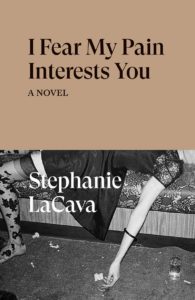
Stephanie LaCava, author of the novel The Superrationals (Semiotext[e], 2020) and the experimental memoir An Extraordinary Theory of Objects (Harper, 2012), has written her second novel, I Fear My Pain Interests You (Verso Books, 2022). The novel’s protagonist, Margot Highsmith, cannot feel physical pain due to a rare medical condition. Margot grows up the daughter of punk rock royalty in a boundaryless, musical atmosphere, and becomes a poster child for “how far can too far go?”
Now an adult, Margot has soured on love, which her best friend chalks up to her childhood neglect. An actress by trade, Margot pursues romantic relationships with people who go out of their way not to meet her needs. In order to feel anything, Margot has become addicted to broken intimacies with abusive men. All this changes when she meets a discredited surgeon in a Montana graveyard, a man who opens the door to a study of both the peculiarities of her body and the absurdities of her famous family.
LaCava is also the publisher of Small Press, an independent outlet focusing on translated works and children’s stories that eschew the risk-mitigating commercial requirements on which publication is normally dependent. Her latest release was Claire Foster’s English translation of actor Pierre Clémenti’s prison memoir A Few Personal Messages.
Through correspondence, LaCava and I discussed her new novel’s lack of a unified, lateral world, the war between volition and intention, and how a lifestyle of curation and distribution can go hand in hand.
***
The Rumpus: You’ve developed a unique prose style for the book, one which reflects Margot’s position as a teenager on the cusp of adulthood. Voice-driven fiction about the travails of youth—books like Padgett Powell’s Edisto or Katherine Dunn’s Attic—are perhaps best remembered for their ability to portray the confusion besetting a still developing mind. How did you piece together the constituent parts that would become Margot’s signature way of speaking?
Stephanie LaCava: There is an aspect of the language of observation in the book that feels like seeing something for the first time. This lends itself well to seem like the eyes of a young mind, but I really think I write with this voice in general. It’s better honed here than in the past. The cadence and punctuation is similar, I think, to what you’d find in some French novels. It’s less expected in American English books.
Rumpus: Margot Highsmith is the daughter of celebrity musicians reminiscent of Kurt Cobain and Courtney Love, Peter Perrett and Zena Kakouli, or perhaps Kim Gordon and Thurston Moore. What attracted you to writing about the trappings of fame and the irreconcilable idea of a rock ’n’ roll parenthood?
LaCava: I wasn’t thinking of modeling the parents on any existing couples. It’s often a question I’m asked and for sure there was no one in mind. Instead, I was thinking about first, the anarcho-punk band Crass and Dial House in regards to the scene where Rose (Margot’s mother) is gardening, and then, simply any dynamic within the culture industry that celebrates a kind of credibility from being underground, which is easily lost with popularity or chance mass appeal.
Rumpus: Alan Kleinberg’s famous photo of Cramps’ guitarist Poison Ivy lying down in the green room of the Mudd Club graces the cover of Pain. How did you want this iconic image to contextualize the story of the Highsmiths? I couldn’t help but think of the lyrics to “What’s Inside a Girl?”
LaCava: Poison Ivy is, of course, an example of a very strong female punk lead. Lux Interior—her partner and band mate—is sometimes the one to wear heels onstage. Their love always seemed fierce and not performative, though they were consummate performers. I like the power of Poison Ivy as a front woman and also the imagery of the band. Gothic horror, an embrace of inversions, a name that’s meant to be crass, gross. It’s an overall aesthetic that haunts the book, as well.
Rumpus: Pain engages with body horror and a genre of cinema known as cinéma du corps, perhaps made most famous by French filmmaker Catherine Breillat; such films explore the ways in which bodies can be prisons or sources of delight in context-dependent scenarios. Can you talk about your fascination with this type of cinema, and why you found it conducive to writing?
LaCava: I am obsessed with this genre of film. I also think of Claire Denis’ Trouble Every Day, and more recently Julia Ducournau’s Raw, which, funnily enough, means “grave” in French, but also translates to “serious,” too. Much of my work is based in images, not necessarily moving images, but stills that circulate. I think about how when we are asked about our first memories, we usually cite something we have also seen a photograph of. Part of cinéma du corps is the ability to have a distanced moving image create a haptic quality in the viewer and the in-between parts—the missing parts that create tension or sensation or the threat of violence. Violence can happen in many ways and take different forms.
Rumpus: Margot’s way of thinking and the concomitant actions they inspire—you describe it in the book as a kind of war between volition and intention—are meant to create a sense of imbalance in a reader. With the introduction of the surgeon, Graves, in the book, Margot is given a medical diagnosis accounting for her actions in a reevaluative light, and the book suddenly reveals its secrets to a reader. Did you know early on that Pain would have this kind of critical, unlocking pivot point in its structure?
LaCava: I wasn’t sure exactly how it would play out, but I knew it would be integral to the plot—or lack of one, in a way.
Rumpus: One of the main themes of the book is the contrast you make between vulnerable love and controlling love. Margot’s story is defined by her resistance to her grandmother Josephine’s obsessive need to surveil her loved ones; by her search for a kind of romantic love that is defined by unselfishness. Why did you choose to write about this?
LaCava: I think I wanted to write about these loves because they were confusing to me in my own life. Finding a definition of what it means to act out of love—whether that be the ability to give real true attention for unselfish reasons or sometimes walking away from someone or something? These kinds of human questions without answers are always in the ether, and throughout literature, delivered differently.
Rumpus: You end the book on a slightly ambiguous note, where there is a violation that forever changes the life of Margot, and allows her to find salvation of sorts. Can you discuss this unity of opposites? The potential for one moment to contain infinitudes of meaning might relate to this idea in the novel that trauma can be transformed and that “what was destructive becomes generative”?
LaCava: It’s interesting as this moment has been read differently by various readers. What is certain to me is that it is meant to be just that—a self-aware moment when what has been destructive and could continue to be destructive in generations to come is changed over into something that is generative or eclipsed or learned from. Something shifts in a person’s legacy—not only familial, but in terms of their own actions. This can be caused by something horrible, but in this context it is also a choice, I think. There is an element of mastering one’s story—of taking back agency along with the narrative.
Rumpus: Fiction can be a direct response to events in a writer’s life or maybe even another literary work itself, but it can also arise from a desire to create a moment which currently does not exist. I’m wondering if you can talk about whether any of these impulses were directly responsible for the writing of Pain, The Superrationals, or An Extraordinary Theory of Objects?
LaCava: All of the above were their own kind of exorcisms in reaction to past experiences. It’s pretty clear that I don’t write autofiction, I think, but I’m not sure if that’s what you meant. Objects was non-fiction/memoir but in an experimental way for sure—maybe that’s the closest I’ve done to autofiction. I think that book makes more sense in the context of it being a part of a larger body of work now, which includes some shorter pieces of criticism or interviews.
The moment that doesn’t exist in Pain is a more unified, lateral world.
Rumpus: You have your own publishing company called Small Press, which focuses on translated works and children’s literature. You have talked about this iconoclastic desire to publish titles that would not normally meet the minimum requirements of success to merit a resurrection. Do you see yourself continuing this model of curation with future acquisitions?
LaCava: For sure. It certainly isn’t a functioning business in the sense of it being a for-profit model. It’s a lot of work in addition to my own creative writing that I do mostly alone. This involves a lot of logistics too. It would be super fun if I could just choose things and make it happen, but it’s not like that from the inside. So I can’t do as much as I would like, but that kind of slower work is good for me, as well. The need to pause and look at all the sides and how it goes out in the world.
Rumpus: Your October 2022 release of Claire Foster’s translation of Pierre Clémenti’s prison memoirs A Few Personal Messages coincided with the MoMA’s retrospective on his career. What has the reception been towards a twenty-first century reappraisal of one of France’s most enigmatic cultural figures?
LaCava: I like enigmatic figures, so maybe I did him a grand disservice. Jury’s still out, so to speak. Honestly, though, that was planned together as a celebration of his work and his journal that advocates for prison abolition. All jokes aside: I think there is a desire for creative figures in glamorous disguises who make choices based on what’s right for them and not a game of compromises for attention. Of course, this creates its own kind of attention and then round and round we go.
Rumpus: Maybe it’s something of a purist attitude, but there is this idea that creative industries can’t thrive until they embrace their medium-specific limitations; that books, podcasts, plays, or what have you, need to focus on qualities that make those forms of expression unique. Your career seems to embrace the opposite idea, which is that the more mediums talk to each other, the more fertile the results of that creative exploration will be. Pain engages with film theory and music culture, and you are both a creative practitioner and the means to distribute content in your capacity as author and publisher. Can you speak about the role that hybridity plays in your artistic process?
LaCava: I do think about this, and am active in the distribution and curation of the image/packaging of the work. Maybe I think that somehow this makes it more DIY or pure even though it’s in a larger system, which obviously isn’t true. There is a hyper self-awareness in all my work that acknowledges—teases itself, maybe—what it is addressing and from what entry point. I once modeled in a campaign for socks I designed for a skate label and on the box there was a small excerpt from one of my books.
***
Author photo by Roe Ethridge






